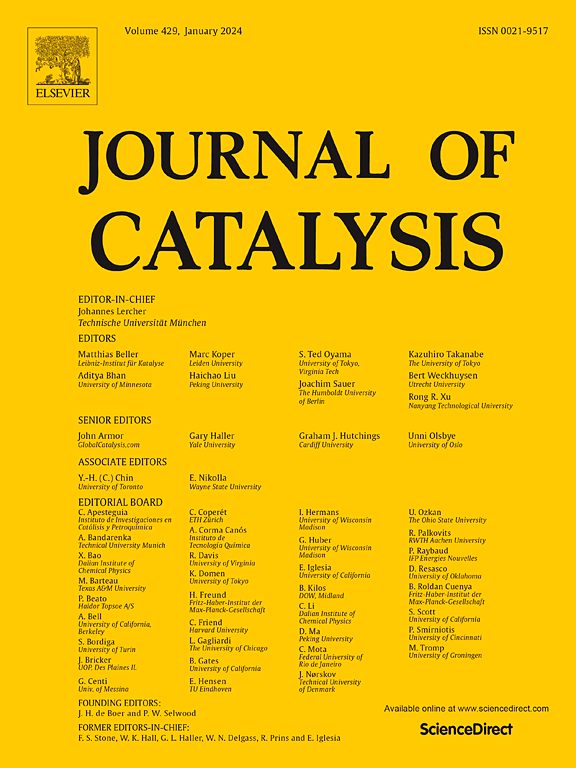Cu和Ga在Ce0.9Zr0.1O2上的双位点用于CO2加氢制甲醇
IF 6.5
1区 化学
Q2 CHEMISTRY, PHYSICAL
引用次数: 0
摘要
铜基催化剂由于其效率、选择性和成本效益,在二氧化碳加氢制甲醇方面具有很高的吸引力。为了进一步加速甲醇合成,双位点活化机制特别有效。在这个方向上,固溶体作为有效的支持,通过改进氢化来提高甲醇的产量,尽管cuga基固溶体中活性位点的确切性质尚不清楚。在这项研究中,我们研究了沉积在Ce0.9Zr0.1O2上的Ga和Cu纳米颗粒/团簇之间的协同作用,以实现co2 -甲醇加氢。通过原位漫反射红外傅立叶变换光谱和程序升温(TPR/TPD)分析了活性位点的性质,并阐明了反应途径。结果表明,适当的Cu/Ga比有利于CO2的吸附和活化,而在甲醇合成条件下,除Cu外,Ga位点对H2解离也起关键作用。此外,CuGa/Ce0.9Zr0.1O2催化剂中的氧空位对稳定关键*HCOO中间体起着至关重要的作用,有利于其通过甲酸途径进一步加氢生成甲醇。Ga和Cu之间的协同作用优化了CO2的活化和加氢步骤,强调了Ga与Cu一起作为活性位点,并突出了催化剂从CO2中高效生产甲醇的潜力。本文章由计算机程序翻译,如有差异,请以英文原文为准。


Cu and Ga dual sites on Ce0.9Zr0.1O2 for CO2 hydrogenation to methanol
Cu-based catalysts are highly attractive for CO2 hydrogenation to methanol due to their efficiency, selectivity, and cost-effectiveness. To further accelerate methanol synthesis, dual-site activation mechanisms are particularly effective. In this direction, solid solutions serve as effective supports, enhancing methanol production through improved hydrogenation, though the exact nature of the active sites in CuGa-based solid solutions remains unclear. In this study, we examine the synergistic interactions between Ga and Cu nanoparticles/clusters deposited on Ce0.9Zr0.1O2 for CO2-to-methanol hydrogenation. Through in situ diffuse reflectance infrared Fourier transform spectroscopy and temperature-programmed (TPR/TPD), we analyze the nature of the active sites and elucidate the reaction pathway. The results demonstrate that CO2 adsorption and activation are favored by the appropriate Cu/Ga ratio, while Ga sites, in addition to Cu, play a critical role in promoting H2 dissociation under methanol synthesis conditions. Furthermore, the oxygen vacancies in the CuGa/Ce0.9Zr0.1O2 catalyst play a crucial role in stabilizing the key *HCOO intermediate, facilitating its further hydrogenation to methanol via the formate pathway. This synergy between Ga and Cu optimizes both CO2 activation and hydrogenation steps, emphasizing Ga as an active site alongside Cu and highlighting the catalyst’s potential for efficient methanol production from CO2.
求助全文
通过发布文献求助,成功后即可免费获取论文全文。
去求助
来源期刊

Journal of Catalysis
工程技术-工程:化工
CiteScore
12.30
自引率
5.50%
发文量
447
审稿时长
31 days
期刊介绍:
The Journal of Catalysis publishes scholarly articles on both heterogeneous and homogeneous catalysis, covering a wide range of chemical transformations. These include various types of catalysis, such as those mediated by photons, plasmons, and electrons. The focus of the studies is to understand the relationship between catalytic function and the underlying chemical properties of surfaces and metal complexes.
The articles in the journal offer innovative concepts and explore the synthesis and kinetics of inorganic solids and homogeneous complexes. Furthermore, they discuss spectroscopic techniques for characterizing catalysts, investigate the interaction of probes and reacting species with catalysts, and employ theoretical methods.
The research presented in the journal should have direct relevance to the field of catalytic processes, addressing either fundamental aspects or applications of catalysis.
 求助内容:
求助内容: 应助结果提醒方式:
应助结果提醒方式:


